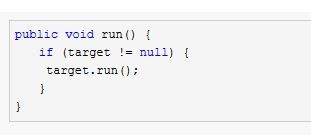java如何实现多线程
1、方法一:继承Thread类创建线程Thread类本质上是实现了Runnable接口的一个实例,代表一个线程的实例。启动线程的唯一方法就是通过Thread类的start()实例方法。start()方法是一个native方法,它将启动一个新线程,并执行run()方法。这种方式实现多线程很简单,通过自己的类直接extend Thread,并复写run()方法,就可以启动新线程并执行自己定义的run()方法。例如:
public class MyThread extends Thread { public void run() { System.out.println("MyThread.run()"); } } MyThread myThread1 = new MyThread(); MyThread myThread2 = new MyThread(); myThread1.start(); myThread2.start();

2、方法二:实现Runnable接口创建线程如果自己的类已经extends另一个类,就无法直接extends Thread,此时,可以实现一个Runnable接口,如下:
public class MyThread extends OtherClass implements Runnable { public void run() { System.out.println("MyThread.run()"); } }

3、为了启动MyThread,需要首先实例化一个Thread,并传入自己的MyThread实例:
MyThread myThread = new MyThread(); Thread thread = new Thread(myThread); thread.start();

4、事实上,当传入一个Runnable target参数给Thread后,Thread的run()方法就会调用target.run(),参考JDK源代码:
public void run() { if (target != null) { target.run(); } }

5、方法三:实现Callable接口通过FutureTask包装器来创建Thread线程
Callable接口(也只有一个方法)定义如下:
public interface Callable<V> { V call() throws Exception; }
public class SomeCallable<V> extends OtherClass implements Callable<V> {
@Override public V call() throws Exception { // TODO Auto-generated method stub return null; }
}
Callable<V> oneCallable = new SomeCallable<V>(); //由Callable<Integer>创建一个FutureTask<Integer>对象: FutureTask<V> oneTask = new FutureTask<V>(oneCallable); //注释:FutureTask<Integer>是一个包装器,它通过接受Callable<Integer>来创建,它同时实现了Future和Runnable接口。 //由FutureTask<Integer>创建一个Thread对象: Thread oneThread = new Thread(oneTask); oneThread.start(); //至此,一个线程就创建完成了。

6、方法四:使用ExecutorService、Callable、Future实现有返回结果的线程
ExecutorService、Callable、Future三个接口实际上都是属于Executor框架。返回结果的线程是在JDK1.5中引入的新特征,有了这种特征就不需要再为了得到返回值而大费周折了。而且自己实现了也可能漏洞百出。
可返回值的任务必须实现Callable接口。类似的,无返回值的任务必须实现Runnable接口。
执行Callable任务后,可以获取一个Future的对象,在该对象上调用get就可以获取到Callable任务返回的Object了。
注意:get方法是阻塞的,即:线程无返回结果,get方法会一直等待。
再结合线程池接口ExecutorService就可以实现传说中有返回结果的多线程了。
下面提供了一个完整的有返回结果的多线程测试例子,在JDK1.5下验证过没问题可以直接使用。代码如下:
import java.util.concurrent.*; import java.util.Date; import java.util.List; import java.util.ArrayList; /** * 有返回值的线程 */ @SuppressWarnings("unchecked") public class Test { public static void main(String[] args) throws ExecutionException, InterruptedException { System.out.println("----程序开始运行----"); Date date1 = new Date(); int taskSize = 5; // 创建一个线程池 ExecutorService pool = Executors.newFixedThreadPool(taskSize); // 创建多个有返回值的任务 List<Future> list = new ArrayList<Future>(); for (int i = 0; i < taskSize; i++) { Callable c = new MyCallable(i + " "); // 执行任务并获取Future对象 Future f = pool.submit(c); // System.out.println(">>>" + f.get().toString()); list.add(f); } // 关闭线程池 pool.shutdown(); // 获取所有并发任务的运行结果 for (Future f : list) { // 从Future对象上获取任务的返回值,并输出到控制台 System.out.println(">>>" + f.get().toString()); } Date date2 = new Date(); System.out.println("----程序结束运行----,程序运行时间【" + (date2.getTime() - date1.getTime()) + "毫秒】"); } } class MyCallable implements Callable<Object> { private String taskNum; MyCallable(String taskNum) { this.taskNum = taskNum; } public Object call() throws Exception { System.out.println(">>>" + taskNum + "任务启动"); Date dateTmp1 = new Date(); Thread.sleep(1000); Date dateTmp2 = new Date(); long time = dateTmp2.getTime() - dateTmp1.getTime(); System.out.println(">>>" + taskNum + "任务终止"); return taskNum + "任务返回运行结果,当前任务时间【" + time + "毫秒】"; } }

7、代码说明:
